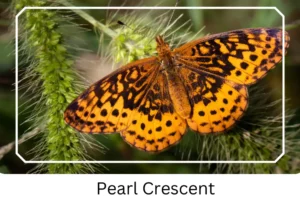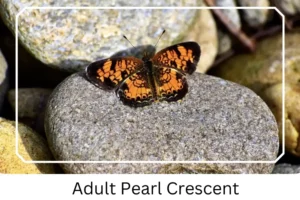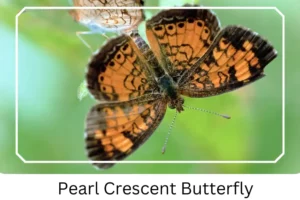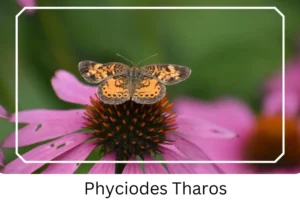Pearl Crescent (Phyciodes tharos)
The Pearl Crescent is a vibrant and enchanting species of butterfly native to North America. Renowned for their striking color patterns, which exhibit slight geographical variations, these butterflies are considered among the most visually appealing in their habitat. Their presence adds a splash of color and life to various landscapes across the continent, making them a subject of interest for both enthusiasts and researchers alike.
Scientific Classification
- Family: Nymphalidae
- Genus: Phyciodes
- Common names: Pearl Crescent
- Scientific Name: Phyciodes tharos
Overview
Pearl Crescents inhabit a broad range of environments, thriving in open, sunny areas. Their adaptability to different ecosystems, coupled with their distinctive physical characteristics, makes them a fascinating study subject. This guide aims to provide a comprehensive overview of the Pearl Crescent, from its early stages as a caterpillar to its majestic adult form, offering insights into its life cycle, habitat preferences, and unique traits.
Description and Identification
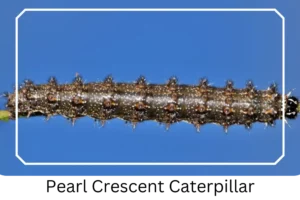
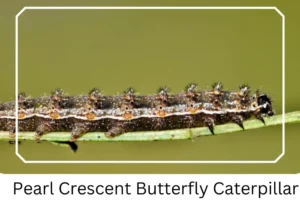 Caterpillar
Caterpillar
The larval stage of the Pearl Crescent is marked by a chocolate brown, white, and black color scheme, adorned with bristles. These caterpillars exhibit communal feeding behaviors, methodically consuming their way down the host plant.
Pupa
Transitioning into the pupa stage, the chrysalis adopts a whitish-grey to yellow-brown hue, characterized by subtle, bumpy ridges on its upper surface, signifying the butterfly’s imminent emergence.
Adult Butterfly
Sexual Dimorphism: The adult Pearl Crescent showcases sexual dimorphism, a phenomenon where males and females exhibit different physical traits. Males are distinguished by a knob at their antenna’s tip, whereas females exhibit a darker coloration. This aspect is crucial for identifying and understanding the species’ reproductive behaviors.
Color and Appearance: In its glory, the butterfly’s wings display a vivid orange with intricate black markings and margins when unfolded. The underside of the wings, when folded, transitions to a grey-brown or orange-brown shade, devoid of black dots but featuring a distinctive white crescent along the border.
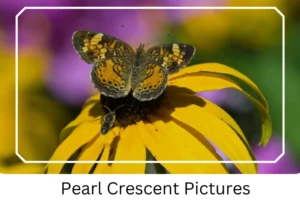
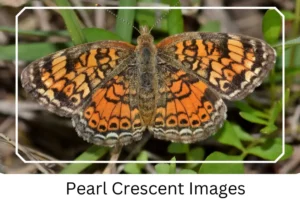 Average Wingspan: The wingspan ranges between 1.18-1.58 inches (3-4 cm), a testament to the butterfly’s petite yet striking presence.
Average Wingspan: The wingspan ranges between 1.18-1.58 inches (3-4 cm), a testament to the butterfly’s petite yet striking presence.
Flight Pattern: Pearl Crescents exhibit an erratic flight pattern, characterized by low, near-ground flights that blend gliding with rapid wing flaps, a behavior that adds to their elusive charm.
Eggs
The green-colored eggs, laid in small clusters under host plant leaves, mark the beginning of the life cycle, showcasing the species’ continuity and survival strategy.
Quick Facts | |
| Distribution | Across the United States (excluding the west coast), Mexico, and Southern Canada. |
| Habitat | Prefers fields, pastures, open pine forests, roadsides, and vacant areas. |
| Host Plants | Utilizes various aster plants for larval development. |
| Adult Diet | Feeds on nectar from swamp milkweed, dogbane, asters, winter cress, and shepherd’s needle. |
How to Identify Pearl Crescent Butterfly?
Identifying a Pearl Crescent can be an engaging yet challenging endeavor, given their similarity to related species like the Northern and Tawny Crescents. Observers should note the butterfly’s size, wing coloration, and patterns, with a particular focus on the white crescent marking on the underside of the wings, a distinctive feature. The erratic, low-flying behavior and preference for sunny, open spaces can also be key identification markers. When examining caterpillars, look for the characteristic brown, white, and black coloration with bristles. Understanding these nuances enhances the observation experience and aids in accurate identification.
Did You Know?
- The Pearl Crescent is often mistaken for its relatives, the Northern and Tawny Crescents, due to their similar appearance.
- This species exhibits a remarkable adaptation to a wide range of habitats, from urban to wild, showcasing its versatility and resilience.
- Pearl Crescents are important pollinators, contributing to the health and propagation of many plant species within their ecosystem.
Conclusion
The Pearl Crescent butterfly is a symbol of the natural beauty and complexity found within North America’s ecosystems. Its lifecycle, from the communal caterpillar stage to the solitary splendor of adulthood, encapsulates the wonder of metamorphosis and survival in the wild. By understanding and appreciating these delicate creatures, we gain insights into the broader ecological webs that sustain life and the importance of conserving diverse habitats for future generations to enjoy.
Pearl Crescent Pictures

Scientific Classification

- Family: Nymphalidae
- Genus: Phyciodes
- Common names: Pearl Crescent
- Scientific Name: Phyciodes tharos

